Themed collection 2020 EES Lectureship Winner: Yana Vaynzof

Ligand dependent oxidation dictates the performance evolution of high efficiency PbS quantum dot solar cells
The stability of lead sulfide (PbS) quantum dots (QD) under continuous illumination in oxygenated environments depends on the choice of ligands, determining the evolution of photovoltaic performance of high efficiency PbS QD solar cells.

Sustainable Energy Fuels, 2020,4, 108-115
https://doi.org/10.1039/C9SE00602H
π-Extended rigid triptycene-trisaroylenimidazoles as electron acceptors
Three blade aroylenimidazoles as soluble electron acceptors for bulk heterojunction solar cells.
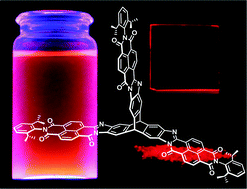
Chem. Commun., 2016,52, 1048-1051
https://doi.org/10.1039/C5CC07238G
Thermally evaporated methylammonium-free perovskite solar cells
Efficient thermally evaporated MA-free perovskite solar cells are developed by optimising their stoichiometry and annealing procedures.
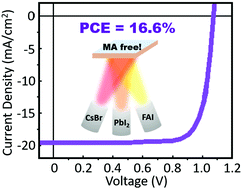
J. Mater. Chem. C, 2020,8, 7725-7733
https://doi.org/10.1039/D0TC01550D
The effect of side-chain length on the microstructure and processing window of zone-cast naphthalene-based bispentalenes
The solubilizing side-groups of solution-processable π-conjugated organic semiconductors affect both the crystal structure and microstructure of the respective thin films and thus charge-carrier mobility in devices.
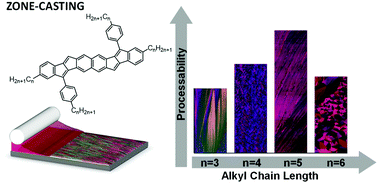
J. Mater. Chem. C, 2019,7, 13493-13501
https://doi.org/10.1039/C9TC04470A
Effect of density of surface defects on photoluminescence properties in MAPbI3 perovskite films
This work investigates the effect of energetically shallow and deep surface defects in MAPbI3 films on the evolution of their photoluminescence properties upon exposure to ambient environment.
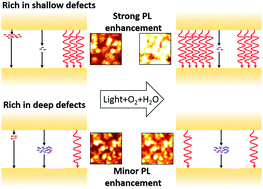
J. Mater. Chem. C, 2019,7, 5285-5292
https://doi.org/10.1039/C8TC05998E
Hierarchical MoS2–carbon porous nanorods towards atomic interfacial engineering for high-performance lithium storage
Downsizing the building blocks of hierarchical structure towards molecular layer level helps to improve the Li storage performance significantly.

J. Mater. Chem. A, 2019,7, 7553-7564
https://doi.org/10.1039/C8TA12293H
Fractional deviations in precursor stoichiometry dictate the properties, performance and stability of perovskite photovoltaic devices
Reproducibility issues of perovskite materials and devices stem from their extreme sensitivity to fractional, quite possibly unintentional, deviations in the precursor solution stoichiometry.

Energy Environ. Sci., 2018,11, 3380-3391
https://doi.org/10.1039/C8EE01136B
Preparation of hierarchical C@MoS2@C sandwiched hollow spheres for lithium ion batteries
Hierarchical C@MoS2@C hollow spheres with active MoS2 nanosheets being sandwiched by carbon layers have been produced using a modified template method.
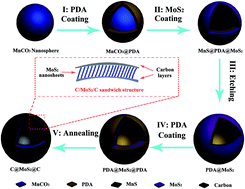
J. Mater. Chem. A, 2017,5, 3987-3994
https://doi.org/10.1039/C6TA10439H
Efficient perovskite solar cells by metal ion doping
Realizing the theoretical limiting power conversion efficiency (PCE) in perovskite solar cells requires a better understanding and control over the fundamental loss processes occurring in the bulk of the perovskite layer and at the internal semiconductor interfaces in devices.

Energy Environ. Sci., 2016,9, 2892-2901
https://doi.org/10.1039/C6EE01969B
The effect of tuning the microstructure of TIPS-tetraazapentacene on the performance of solution processed thin film transistors
We report a comprehensive study of the symmetrical 6,13-bis(triisopropylsilylethynyl)tetraazapentacene used as an electron transporting material in organic field-effect transistors deposited by spin/zone-casting.

J. Mater. Chem. C, 2016,4, 1194-1200
https://doi.org/10.1039/C5TC03326H
Structure formation in P3HT/F8TBT blends
The structure evolution of all-polymer solar cells based on the blends of poly(3-hexylthiophene) (P3HT) and poly[(9,9-dioctyluorene)-2,7-diyl-alt-(4,7-bis(3-hexylthien-5-yl)-2,1,3-benzothiadiazole)-2′,2′′-diyl] (F8TBT) was investigated.

Energy Environ. Sci., 2014,7, 1725-1736
https://doi.org/10.1039/C3EE44125C
About this collection
We are delighted to announce that the 2020 EES Lectureship has been jointly awarded to Professor Yana Vaynzof and Dr Wooyul Kim. To celebrate, we have put together collections of Yana and Wooyul’s publications in Royal Society of Chemistry journals.
You are currently reading Yana’s collection. You can find Wooyul’s collection here.
Yana is an Associate Professor at the Technical University of Dresden, Germany. Since 2019, she has been the Chair for Emerging Electronic Technologies at the Center for Advancing Electronics Dresden, and the Integrated Center for Applied Physics and Photonic Materials. She received her PhD from the University of Cambridge, UK in 2011, and was previously a junior professor at the University of Heidelberg, Germany (2014-2018).
Her research interests focus on emerging photovoltaics based on organic, colloidal quantum dot and perovskite materials. Her work aims to address the challenges of stability and reproducibility of emerging photovoltaic devices by identifying the causes and developing strategies for the mitigation of these challenges. To achieve this, Yana not only utilizes a broad range of experimental methods, but also develops new spectroscopic techniques and methodologies for the study of material physics of novel semiconductors.
Find out more about her research on her website https://cfaed.tu-dresden.de/cfeet-about and on twitter: @vaynzof
She was the only female recipient of an ERC Starting Grant in the panel PE3 Condensed Matter Physics in 2016, and was also the recipient of the 2018 Walter Kalkhof-Rose Memorial Award for outstanding young researchers in the natural sciences as well as the Fulbright-Cottrell Award for innovation in research and teaching.